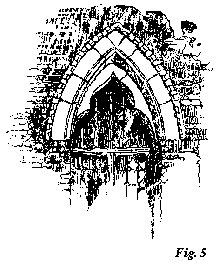288 10. FINAL APPENDIX CUSPS
archivolt mouldings on the projecting edge of 2 and 3, we obtain the bold and deep fifth-order window, used down to the close of the fourteenth century or even later, and always grand in its depth of cusp, and consequently of shadow; but the narrow cusp 4 occurs also in very early work, and is piquant when set beneath a bold flat archivolt, as in Fig. 5, from the Corte del Forno at Santa Marina. The pierced cusp gives a peculiar lightness and brilliancy to the window, but is not so sublime. In the richer buildings the surface of the flat and solid cusp is decorated with shallow trefoil (see Plate 8, Vol. I.), or, when the cusp is small, with a triangular incision only, as seen in figs. 7 and 8, Plate 11. The recesses  on the sides of the other cusps indicate their single or double lines of foliation. The cusp of the Ducal Palace has a fillet only round its edge, and a ball of red marble on its truncated point, and is perfect in its grand simplicity; but in general the cusps of Venice are far inferior to those of Verona and of the other cities of Italy, chiefly because there was always some confusion in the mind of the designer between true cusps and the mere bending inwards of the arch of the fourth order. The two series, 4 a to 4 e, and 5 a to 5 e, in Plate 14, Vol. II., are arranged so as to show this connection, as well as the varieties of curvature in the trefoiled arches of the fourth and fifth orders, which, though apparently slight on so small a scale, are of enormous importance in distant effect; a house in which the joints of the cusps project as much as in 5 c, being quite piquant and grotesque when compared with one in which the cusps are subdued to the form 5 b. 4 d and 4 e are Veronese forms, wonderfully effective and spirited; the latter occurs at Verona only, but the former at Venice also. 5 d occurs in Venice, but is very rare; and 5 e I found only once, on the narrow canal close to the entrance door of the Hotel Danieli. It was partly walled up, but I obtained leave to take down the brickwork and lay open one side of the arch, which may still be seen.
on the sides of the other cusps indicate their single or double lines of foliation. The cusp of the Ducal Palace has a fillet only round its edge, and a ball of red marble on its truncated point, and is perfect in its grand simplicity; but in general the cusps of Venice are far inferior to those of Verona and of the other cities of Italy, chiefly because there was always some confusion in the mind of the designer between true cusps and the mere bending inwards of the arch of the fourth order. The two series, 4 a to 4 e, and 5 a to 5 e, in Plate 14, Vol. II., are arranged so as to show this connection, as well as the varieties of curvature in the trefoiled arches of the fourth and fifth orders, which, though apparently slight on so small a scale, are of enormous importance in distant effect; a house in which the joints of the cusps project as much as in 5 c, being quite piquant and grotesque when compared with one in which the cusps are subdued to the form 5 b. 4 d and 4 e are Veronese forms, wonderfully effective and spirited; the latter occurs at Verona only, but the former at Venice also. 5 d occurs in Venice, but is very rare; and 5 e I found only once, on the narrow canal close to the entrance door of the Hotel Danieli. It was partly walled up, but I obtained leave to take down the brickwork and lay open one side of the arch, which may still be seen.
____________________________
The above particulars are enough to enable the reader to judge of the distinctness of evidence which the details of Venetian architecture bear to its dates. Farther explanation of the plates would be vainly tedious: but the architect who uses these volumes in Venice will find them of value, in enabling him instantly to class the mouldings which may interest him; and for this reason I have given a larger number of examples than would otherwise have been sufficient for my purpose.
[Version 0.04: March 2008]
